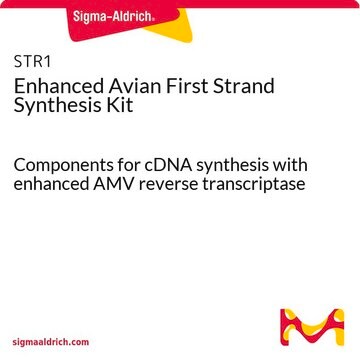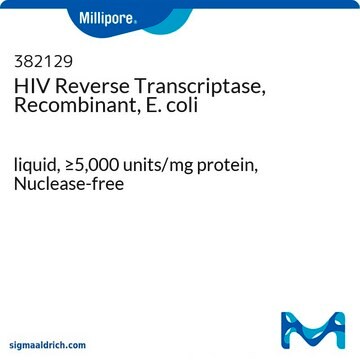TRANSRTRO
Roche
Transcriptor Reverse Transcriptase
About This Item
Produtos recomendados
recombinante
expressed in E. coli
Nível de qualidade
Ensaio
≥90% (SDS-PAGE)
Formulário
liquid
uso
sufficient for 25 reactions
sufficient for 50 reactions
sufficient for 500 reactions
atividade específica
0.05 U/mg
Características
dNTPs included: no
hotstart: no
fabricante/nome comercial
Roche
embalagem
pkg of 200 reactions (03531287001)
pkg of 25 reactions (03531317001)
pkg of 50 reactions (03531295001)
técnica(s)
RT-PCR: suitable
RT-qPCR: suitable
cor
colorless
pH
7.2
solubilidade
water: miscible
adequação
suitable for molecular biology
nº de adesão UniProt
aplicação(ões)
genomic analysis
life science and biopharma
método de detecção
probe-based
atividade externa
DNase activity, none detected
Nicking activity, none detected
RNase activity, none detected
temperatura de armazenamento
−20°C (−15°C to −25°C)
Descrição geral
Aplicação
- Synthesis of first-strand cDNA for use in subsequent amplification reactions
- RT-PCR of GC-rich RNA templates
- Cy3, Cy5, DIG, biotin, and aminoallyl labeling during cDNA synthesis
- Retrieving and cloning the 5′ and 3′ termini of mRNA by RACE
- Generation of cDNA libraries with large inserts
- Dideoxy DNA sequencing
- RNA sequencing
- 3′-end labeling of DNA fragments
- Generation of single-stranded probes for genomic footprints
- In the reverse transcription of RNA from human Papillomavirus E6,[3] cortical and striatal tissues,[4] muscle biopsies of Becker muscular dystrophy samples[5] and miRNA stem-loop from oocytes[6] and human cerebral microvascular endothelial cells (hCMVECs)[7]
Ações bioquímicas/fisiológicas
Características e benefícios
- Achieve high sensitivity in two-step RT-PCR.
- Obtain more full-length transcripts - up to 14 kb.
- Reverse transcribe difficult templates.
- Efficiently label cDNA.
Componentes
- Transcriptor Reverse Transcriptase, in storage buffer
- Transcriptor RT buffer, 5x concentrated
Qualidade
- with a conventional thermal cycler to detect a 10-kb fragment from the human dystrophin gene, starting from human skeletal muscle total RNA
- with the LightCycler® Instrument to detect 5 x 102 to 5 x 106 copies of in vitro-transcribed human PBGD RNA. The results are defined in fixed crossing points and fixed fluorescence intensity.
Nota de preparo
Transcription of long, rare, or difficult RNA targets
Transcriptor Reverse Transcriptase is recommended for RT-PCR of:
- long targets, because it can transcribe up to 14 kb RNA templates
- rare targets, because it has high sensitivity
- GC-rich targets, because it can operate at high temperatures (up to +65oC) to eliminate problems associated with extensive secondary structure
Labeling for many applications
Transcriptor Reverse Transcriptase is also recommended for preparing labeled cDNA, since it accepts a wide variety of modified nucleotides (including Cy3-, Cy5-, DIG-, Biotin-, or aminoallyl-labeled dNTPs).
Reaction requirements
Transcriptor accepts ssRNA and ssDNA templates and requires a primer for transcription.
Armazenamento e estabilidade
Outras notas
Informações legais
Código de classe de armazenamento
12 - Non Combustible Liquids
Classe de risco de água (WGK)
WGK 1
Ponto de fulgor (°F)
does not flash
Ponto de fulgor (°C)
does not flash
Escolha uma das versões mais recentes:
Certificados de análise (COA)
Lamentamos, não temos COA para este produto disponíveis online no momento.
Se precisar de ajuda, entre em contato Atendimento ao cliente
Já possui este produto?
Encontre a documentação dos produtos que você adquiriu recentemente na biblioteca de documentos.
Os clientes também visualizaram
Conteúdo relacionado
A RT-qPCR, ou PCR de transcrição reversa quantitativa, combina os efeitos da transcrição reversa e da PCR quantitativa ou PCR em tempo real para amplificar e detectar alvos específicos. A RT-qPCR tem várias aplicações, incluindo a quantificação dos níveis de expressão gênica, a validação da interferência de RNA (RNAi) e a detecção de agentes patogênicos, como vírus.
RT-qPCR detects specific targets with applications in gene expression and pathogen detection.
Nossa equipe de cientistas tem experiência em todas as áreas de pesquisa, incluindo Life Sciences, ciência de materiais, síntese química, cromatografia, química analítica e muitas outras.
Entre em contato com a assistência técnica













